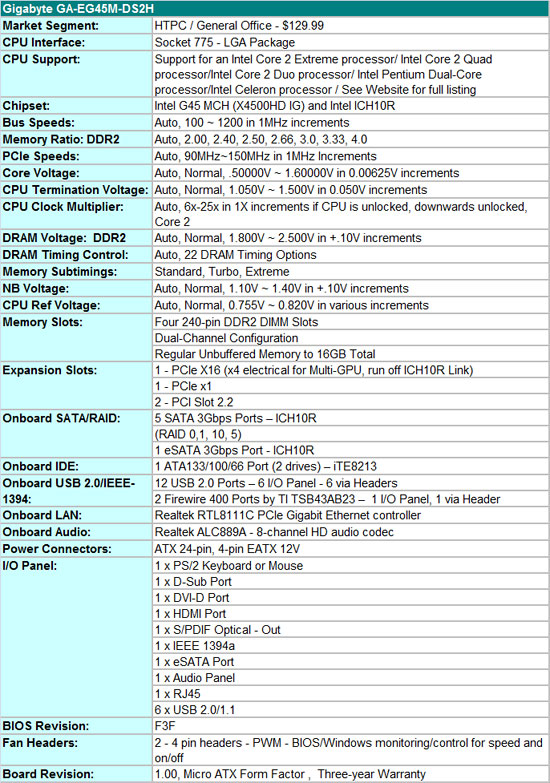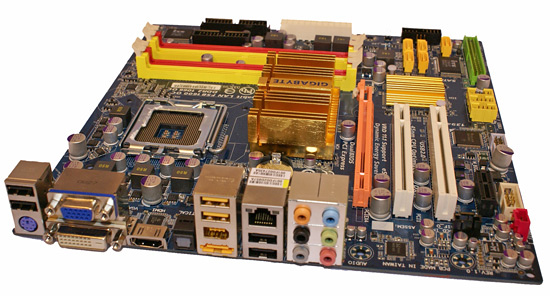The IGP Chronicles Part 1: Intel's G45 & Motherboard Roundup
by Anand Lal Shimpi & Gary Key on September 24, 2008 12:00 PM EST- Posted in
- Motherboards
Gigabyte GA-EG45M-DS2H
Our second board is the Gigabyte GA-EG45M-DS2H and it has an interesting secret hiding underneath an otherwise excellent set of features and BIOS options. In fact, from a layout and component overview, this was initially our favorite board after opening our retail boxes. Why did we change our minds, well Gigabyte decided to take an opposite turn when it came to deciding on the discreet graphics capability for this board. Sometimes, taking a left when everyone goes right is good, but we think Gigabyte missed a great opportunity with this board.

You see, the x16 graphics slot is not run off the MCH that would have provided a true x16 PCIe 2.0 capable slot. Instead, Gigabyte placed an x16 connector on the board that actually runs off the ICH10R at x4 PCIe 1.1 speeds. Not only is this slot bandwidth limited, it must also negotiate with the MCH via the DMI link that further slows progress. This is not bad for simple 2D graphics or even Vista’s Aero interface, but that is the limit. Why did Gigabyte make this decision? They thought the market for true multi-display output via an IG solution that retains its strengths (accelerated BD playback, HDMI audio) was greater than the SFF performance/enthusiast sector.
Gigabyte might very well be right, but we think that market would be more inclined to utilize the G43 or G33 chipsets in a business environment where accelerated BD playback is probably no more warranted than the number of enthusiasts looking to build a SFF performance system. Unfortunately, with the G45 chipset you cannot have both, as the digital output is muxed across the x16 lane in the MCH, which prohibits the use of the X4500HD and a discrete GPU at the same time unless you run the dGPU off the Southbridge.
Otherwise, the BIOS options and feature set of this board matches that of the ASUS and in some ways is better in our estimation. The BIOS offers a dizzying array of options for the enthusiast or for those just wanting to undervolt their system in order to save energy costs. Gigabyte continues with their Crtl-F1 policy for accessing the advanced options in the BIOS. The GA-EG45M-DS2H features Realtek RTL8111C PCIe Gigabit Ethernet, Firewire 400 support from a TI chipset, PATA support via the iTE8213 (noticed a pattern yet that JMicron is out, so we rejoice), HD audio from the now standard ALC889a codec featuring DTS Live and Dolby Home Theater capabilities, and RAID from the ICH10R. Of note, the latest version of Gigabyte's DES power saving technology actually performed slightly better on this board than the ASUS EPU-4 engine on the P5Q-EM. Overall, Gigabyte built a high quality and full featured uATX board that should satisfy just about any HTPC or SOHO user.

Gigabyte provided a very good layout if one considers that a discrete graphics card will probably never be used in this board. If so, we found it difficult to change the memory with a full-length video card in the slot. Our only other problem is that low profile CPU fan/heatsinks like the Arctic Cooling Freezer 7 LP will not work due to the height of the MCH heantsink. Otherwise, we did not have any further problems when installing a variety of peripherals. The MCH and ICH heatsinks provided adequate cooling in our Thermaltake case during 24/7 operation.
Gigabyte also utilizes an excellent four-phase power delivery system along with very good solid capacitors throughout the board that resulted in superb stability throughout our four hundred hour testing regimen. We utilized the latest F3F BIOS that features several improvements including enhanced 8GB compatibility along with memory performance enhancements, additional processor support (EO steppings), and improved overclocking support with lower end processors like the E5200. Support from Gigabyte has been very good on this product.
We were able to reach the 407~412FSB range when overclocking with the X4500HD active. This matches the ASUS board and seems to be the level where stability is still possible when utilizing the IG core. We were able to go higher, but started running into application problems, mainly games like Age of Conan and BD playback. Neither of which we would normally utilize with an overclocked system. In fact, we tend to want to underclock and undervolt our home theater systems during playback sessions. As far as the performance penalty incurred for running a card like the AMD 4850 or NVIDIA 8800GT off the Southbridge, it tends to be around 15~22%. We are running tests with the AMD 4670/NV 9600GT cards and will report additional results in our final article.
We would like to commend Gigabyte for their new labeling design on the various USB, Firewire, and other connectors on the motherboard. It would not be a typical article without us commenting on the crayola color scheme but we have come to accept it as Gigabyte’s trademark. However, the last time we checked, colors did not make or break a board’s stability or performance. That said, keeping things cool when running a 24/7 media center is important and the fact that this board only had two fan headers is a bit puzzling. The fan control and monitoring via the BIOS or Windows is very good, we just expected another fan header to be included. S1 and S3 resume support worked correctly with a variety of components and BIOS selections.
Pros/Cons
Overall, we have a board that confuses us (yes, shiny trinkets do the same but bear with us on this one). The design, component selection, BIOS options, and general performance scream of a board that is just waiting to go into a performance oriented SFF system. We were hyped about comparing the ASUS and Gigabyte boards against each other in a future SFF guide. After reading the specifications and then contacting Gigabyte to be make sure the technical document group did not screw up, we had a supreme let down.
However, this chipset is targeted to the multimedia and SOHO crowd and as such, we cannot fault Gigabyte too much for their decision, as unpopular as it seems. On the plus side, Gigabyte did include an eSATA port on the IO panel and if you must use onboard audio, they have the best solution in this roundup. If we were to improve the board, our first item would be a true x16 PCIe slot for graphics, then a different MCH heatsink design, and finally at least one more fan header. If you need a feature rich and high quality motherboard for HTPC or SOHO duties only, then the Gigabyte FA-EG45M-DS2H is an excellent choice.
















53 Comments
View All Comments
kilkennycat - Wednesday, September 24, 2008 - link
Anand and Gary,Seems as if an important candidate is MIA in your 3-part review of integrated chip-sets/uATX motherboards, the LONG-promised nVidia MCP7A chip-set for Intel processors with integrated 9400/9300 graphics. The only potential integrated-graphics competitor to the G45 in the Intel-processor world. When is the MCP7A due to be released? Most recent speculation (in DigiTimes, iirc) was the end of this month (September). In time to add a review of one or more uATX motherboards based on this chipset as Part 4 to this group of three reviews?
Anand Lal Shimpi - Wednesday, September 24, 2008 - link
By the time this series is over the MCP7A won't be out, but we'll have a standalone review of that product to coincide with availability :)-A
yehuda - Thursday, September 25, 2008 - link
Ok, when will this series be over? I ask because the last news on MCP7A said that it should be out before the end of this month and your statement makes me wonder if there's another delay ahead.kilkennycat - Wednesday, September 24, 2008 - link
Anand, thanks for the reply.NDA gag on projected-availability information from nVidia ??
Anand Lal Shimpi - Wednesday, September 24, 2008 - link
Yep, it won't be too much longer and NV is quite excited about it but specifics I can't give out unfortunately.*If* I were in NVIDIA's shoes I'd want to capitalize as best as possible on Intel's handling of G45. I'd make sure that the first products worked *perfectly* and availability was immediate and at competitive prices.
If NVIDIA blows this opportunity I'll be quite disappointed, especially given how much crap it has given Intel about Larrabee.
We'll know soon enough, but after the IGP Chronicles are over :)
-A
Pederv - Wednesday, September 24, 2008 - link
From what I read, the G45 can be summed as, "It has a few good points but over all it sucks."kevinkreiser - Wednesday, September 24, 2008 - link
I was hoping there would be mention of the graphics problems when putting nvidia cards in these boards. I was very vocal about this over at the AVS forums. Did any one notice any mention of this in the article? Also will there be coverage of the new nvidia boards MCP7A?Gary Key - Wednesday, September 24, 2008 - link
Our final article will feature the discrete cards like the 9600GT and HD 4670. In testing so far, I have not had the problems that have been reported. I do have some additional NV cards coming to test. We will have coverage on the GeForce 9400 series when it launches. ;)kevinkreiser - Wednesday, September 24, 2008 - link
Thanks for the quick reply. I appreciate you guys keeping an eye out for the aforementioned problem. And also thanks for the heads up on the forthcoming MCP7A article.sprockkets - Wednesday, September 24, 2008 - link
http://www.newegg.com/Product/Product.aspx?Item=N8...">http://www.newegg.com/Product/Product.aspx?Item=N8...Shame it costs $100 though. Shame too that Intel boards work so poorly, since I like that mini-itx board. The one from Jetway for the 8200 chipset probably doesn't work any better.